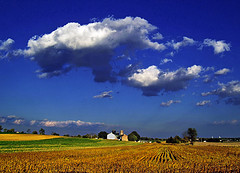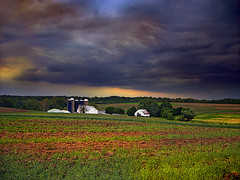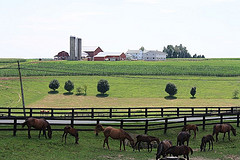The Certificate in Land Preservation at the University of Pennsylvania
By: Amos S. Eno
Posted on:10/05/2010Tom Daniels has designed the country’s only certificate program for land preservation, in operation for the past three years.
Like so many peop le who do cutting edge work, Tom Daniels kind of breaks the mold. He grew up in Vermont, occasionally working but never living on a farm. He earned a Ph.D. in agricultural economics, and then as he puts it, “kind of morphed into a planner.”
le who do cutting edge work, Tom Daniels kind of breaks the mold. He grew up in Vermont, occasionally working but never living on a farm. He earned a Ph.D. in agricultural economics, and then as he puts it, “kind of morphed into a planner.”
After a few years of teaching planning, he went to work for the Lancaster County farmland preservation program from 1989 to 1998. As luck would have it, one year before he began, Pennsylvania established a statewide agricultural easement program. “I was fortunate to be working there right as money from the state started flowing in. We had a good amount to work with.”
Tom’s work on farmland preservation occurred in one of the nation’s top 20 agricultural counties. Lancaster, known as the heart of Amish country, is comprised of more than two-thirds agricultural land. Partially due to visionary agricultural zoning throughout the 70s and 80s and partially because agriculture is a $1 billion industry that is also essential to the thriving tourist trade, Lancaster county has more of its farmland preserved than any other county in the United States. Almost 90,000 of its 400,000 agricultural acres have been permanently protected.
Tom next did a stint at SUNY-Albany in New York, where his original land preservation course proved popular with the students. Upon his return to UPenn, he got input from Peter Stein of Lyme Timber - a leading conservationist - on how to turn the course into a certificate program.
The program got an enthusiastic green light from the rest of his faculty, and it’s been running for three years now. Six master’s students have graduated with the certificate, and Toms says, “the first one walked right into a land trust executive director job. Another is starting next week with a land trust. Often when a new person is hired right out of graduate school, it takes six months to train them. Our program enables them to hit the ground running.”
The Land Preservation Certificate
What are the five elements of the UPenn Land Preservation Certificate? They are land preservation and planning, land conservation finance, geographic information systems, environmental law, and a science course such as wetland ecology or land remediation.
It’s hard for me to believe that this program has not yet been replicated. Tom is planning on growing his program at UPenn, but he says “I’d like to see other universities adopting land preservation courses if not certificates, so that we can train the next generation to do good work in land preservation. Given the population growth we’re facing, it will just become more important. I’m happy to talk to other institutions and practitioners.” 
Tom’s sense of urgency derives from what the Census Bureau tells us: our country has a population of 310 million people today, but we’ll likely have 440 million by 2050. “Our challenge,” says Tom, “is where do you put another 130 million Americans, and where are they going to get clean fresh water, food to eat, space to recreate, and what will be the impacts on wildlife? Unless we do some very serious planning right now, we could end up with that much more sprawl, which has decimated wildlife and resulted in only 60% of our water designated as swimmable and drinkable.”
Tom’s certificate program includes a focus on how to make government and land trusts more strategic. “In Lancaster County, we have 3 complementary techniques for protecting farmland:
1. We go out and buy easements (development rights).
2. More than half of the county’s farmland has agricultural zoning, which means no greater than one house on two acres for every 25 acres. For example, 100 acres could get 4 building lots on a total of 8 acres and still have 92 acres remaining for agriculture.
3. Several local townships have put in place urban growth boundaries to limit the extension of sewer and water lines, but this has always been done with the buy-in of county government.”
Our Future Depends on Good Stewardship
I asked Tom what he thinks of the new focus on payments for “ecosystem services,” or the benefits provided by natural lands, including working lands. “What we’re moving towards is actually some kind of arrangement to pay farmers and forest owners for ecosystem services, whether for carbon sequestration to mitigate climate change or to improve water supply.
“When we purchase a f arm conservation easement in Lancaster, we require a soil and water conservation plan. We want to go beyond preservation and ensure good stewardship; that’s very important. Any particular farm that has been preserved is a piece of advertising for your organization. If it’s poorly managed, it does not reflect well on the land trust or the government.”
arm conservation easement in Lancaster, we require a soil and water conservation plan. We want to go beyond preservation and ensure good stewardship; that’s very important. Any particular farm that has been preserved is a piece of advertising for your organization. If it’s poorly managed, it does not reflect well on the land trust or the government.”
Besides, Lancaster County is in the Chesapeake Bay watershed. As you might have heard, Chesapeake Bay is a body of water that has been profoundly affected by the expanding demands of an increasing population, with pollution that now threatens not only aquatic but human health. Over the past 60 years, the watershed’s population tripled, from 8.3 to 16.9 million people. That number is expected to top 20 million by 2020.
 Sign In
Sign In
 Sign In
Sign In
